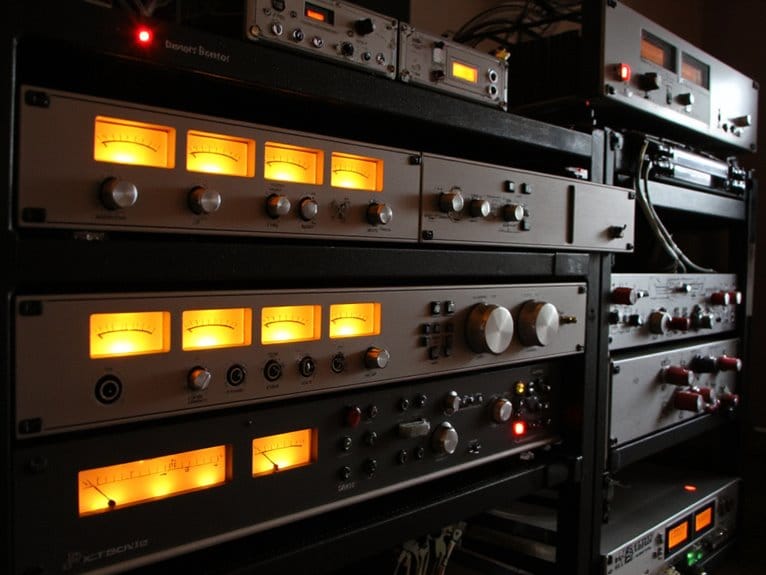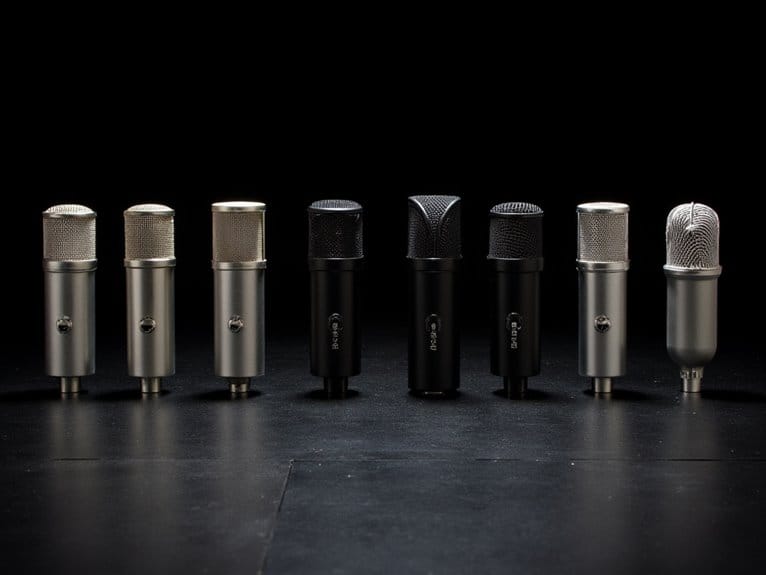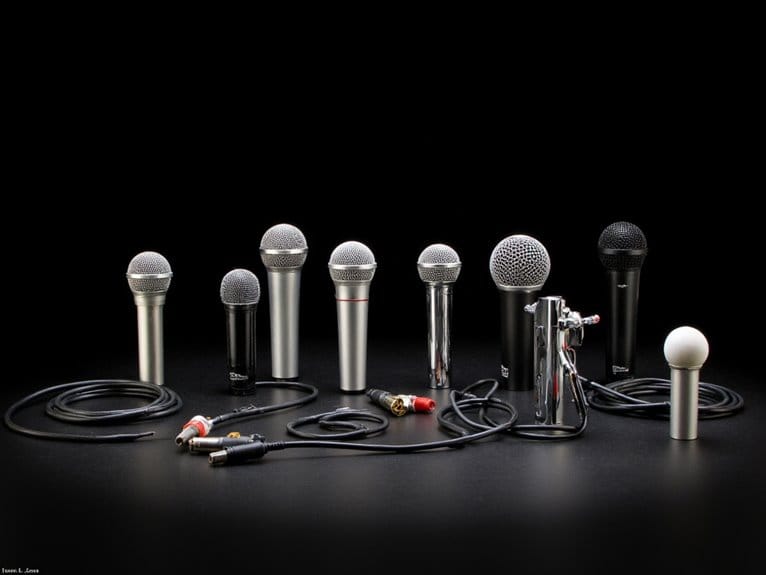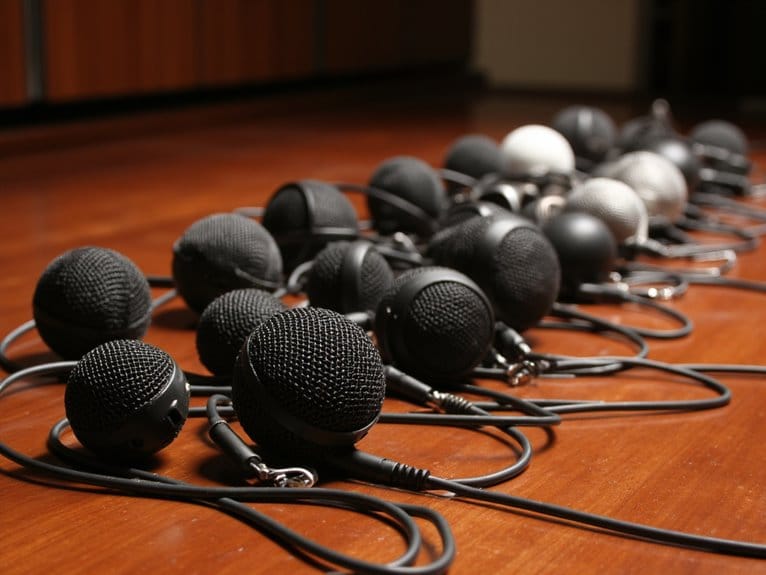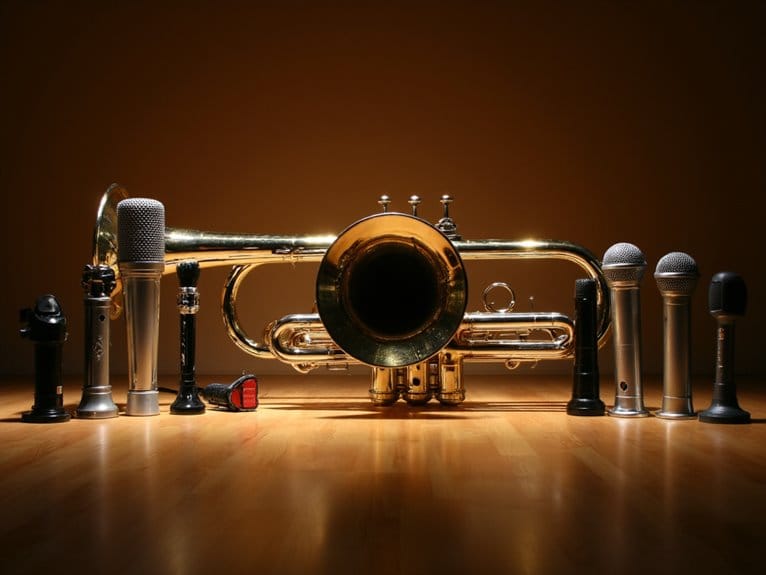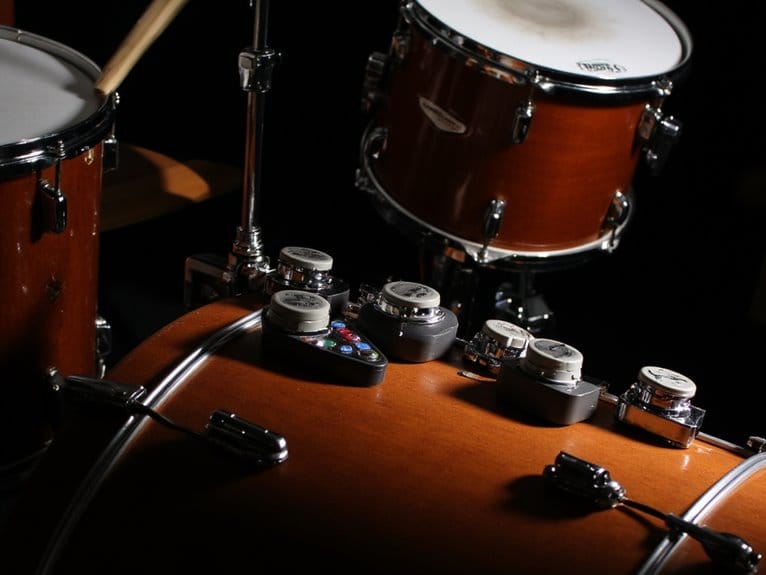10 Best Mic Preamps for Crystal-Clear Audio Recording
I’ve found the RO-04 Pro delivers exceptional 72dB gain with a -120dB noise floor, making it perfect for demanding dynamics like the SM7B, while the Elgato Wave XLR offers 75dB gain plus Clipguard technology for streamers. The Cloudlifter CL-1 provides ultra-clean 25dB boost for ribbons, and PreSonus TubePre v2 combines tube warmth with solid-state clarity at 80dB gain. Each excels in specific scenarios, and understanding your microphone’s requirements will help you discover which preamp transforms your recordings.
We are supported by our audience. When you purchase through links on our site, we may earn an affiliate commission, at no extra cost for you. Learn more.
Notable Insights
- The RO-04 Pro offers exceptional 72dB gain with -120dB noise floor, perfect for demanding dynamic microphones like the SM7B.
- Elgato Wave XLR provides 75dB ultra-low-noise gain with Clipguard technology and Wave Link app for seamless streaming integration.
- Cloud Microphones Cloudlifter CL-1 delivers +25dB ultra-clean gain with 5Hz-80kHz frequency response, ideal for ribbon and vintage dynamics.
- PreSonus TubePre v2 combines 12AX7 tube warmth with solid-state clarity, offering 80dB gain and dual-mode operation flexibility.
- Behringer ADA8200 expands recording capacity with eight simultaneous microphone inputs and 24-bit conversion quality via ADAT optical connection.
RO-04 Pro Mic Preamp with Hi-Z for Dynamic Condenser Microphones

The RO-04 Pro Mic Preamp stands out as my top recommendation for content creators who demand professional audio quality without sacrificing portability, combining the refined circuit design of its predecessor with enhanced features that address real-world recording challenges. You’ll appreciate the 72dB maximum gain handling demanding dynamic mics like the SM7B, while the Type-C power port lets you run sessions using phone chargers or power banks – something I’ve found invaluable for outdoor shoots. The 11-step attenuator prevents the overload distortion that’s plagued my recordings before, and that -120dB noise floor delivers surprisingly clean signals even at high gain.
Best For: Content creators, podcasters, and mobile recording enthusiasts who need professional-grade audio quality with the flexibility of portable, power bank-compatible operation.
Pros:
- Exceptional 72dB gain with ultra-clean -120dB noise floor, perfect for demanding dynamic microphones like SM7B
- True portability with Type-C power port that works with phone chargers and power banks for outdoor recording
- Precision 11-step attenuator prevents overload distortion while built-in phantom power and HPF enhance versatility
Cons:
- Power block and USB-C cable length limitations noted by users
- Higher price point compared to basic preamp options
- May be overkill for casual users who don’t require professional-grade features
Coda MB-1 Microphone Preamp with 48V Phantom Power

Budget-conscious content creators and podcasters will find their sweet spot with the Coda MB-1 Microphone Preamp, a no-nonsense gain booster that delivers 25dB of clean amplification without breaking the bank. This phantom-powered preamp works exclusively with dynamic and ribbon microphones, requiring your audio interface’s 48V supply to function properly. At -70dB noise floor, you’ll get respectable performance that rivals pricier alternatives like Cloudlifter, though admittedly without the premium build quality. The MB-1’s straightforward design eliminates unnecessary controls, focusing purely on signal enhancement for microphones like the Shure SM7B during studio sessions, live streaming, or broadcast applications.
Best For: Budget-conscious content creators, podcasters, and musicians who need clean gain boost for dynamic or ribbon microphones without spending premium prices.
Pros:
- Delivers 25dB of clean amplification with -70dB noise floor at a cost-effective price point
- Simple plug-and-play design with no controls to adjust, making it straightforward to use
- Strong performance that rivals more expensive alternatives like Cloudlifter for most applications
Cons:
- Requires external 48V phantom power to function and won’t work without it
- Not compatible with condenser microphones, limiting versatility
- Larger size (7 x 3 x 2.25 inches) makes it less convenient for mobile or portable setups
Microphone Preamp Booster with 25dB Gain & Phantom Power

Content creators working with dynamic and ribbon microphones will find exceptional value in this compact powerhouse, which delivers ultra-clean 25dB gain through innovative OFCOSH technology that eliminates the hiss and distortion typically associated with budget preamps. You’ll appreciate its plug-and-play simplicity, though I’ll admit the aluminum housing feels more premium than expected for this price point. The 30% signal clarity boost transforms quiet vocals and instruments, making it particularly effective for podcasters and streamers who need consistent audio without investing in high-end gear. While it won’t pass phantom power to delicate ribbon mics, its compatibility with broadcasting mixers and DAWs makes setup straightforward for most applications.
Best For: Content creators, podcasters, streamers, and musicians who use dynamic or ribbon microphones and need clean, affordable gain boosting without investing in high-end preamp equipment.
Pros:
- Ultra-clean 25dB gain with OFCOSH technology that eliminates hiss and distortion while providing 30% signal clarity boost
- Plug-and-play design with durable aluminum housing that’s compatible with broadcasting mixers and DAW setups
- Exceptional value at one-third the cost of high-end preamps while delivering comparable performance
Cons:
- Not suitable for condenser microphones that require phantom power, as it doesn’t pass phantom power through to connected mics
- Limited to 25dB gain which may not be sufficient for extremely quiet sources or very low-output microphones
- Requires an external device that supplies +48V phantom power to operate, adding complexity to some setups
Cloud Microphones Cloudlifter CL-1 Mic Activator Preamp

When you’re dealing with ribbon microphones, vintage dynamics, or any microphone that demands substantial clean gain without introducing unwanted noise, the Cloud Microphones Cloudlifter CL-1 stands as the gold standard that countless audio professionals have relied upon since 2011. This compact, USA-made preamp delivers up to +25dB of ultra-clean gain while maintaining an impressive 5Hz-80kHz frequency response and 35dB signal-to-noise ratio. You’ll find it particularly effective with gain-hungry mics like the Shure SM7B, where it transforms weak signals into robust audio without the typical hiss you’d expect from cranking your interface’s preamp. The plug-and-play operation requires only 48V phantom power, making it versatile across home studios and professional setups.
Best For: Audio professionals and content creators working with ribbon microphones, vintage dynamics, or gain-hungry mics like the Shure SM7B who need substantial clean gain without introducing noise in home studios or professional recording setups.
Pros:
- Delivers up to +25dB of ultra-clean gain with impressive 5Hz-80kHz frequency response and 35dB signal-to-noise ratio
- Simple plug-and-play operation requiring only 48V phantom power with no complex setup or configuration needed
- Made in USA with proven durability and consistent performance, earning 4.7/5 stars from over 4,000 users since 2011
Cons:
- Requires 48V phantom power from your audio interface or mixer to operate, limiting compatibility with some basic setups
- At 11.3 ounces, it adds physical weight and bulk to your signal chain compared to software-based gain solutions
- Some users have reported initial product issues despite the overall positive reviews and reputation
Elgato Wave XLR Audio Mixer and Preamp for XLR Mic to USB-C

Since streaming and content creation have become legitimate career paths, the Elgato Wave XLR Audio Mixer and Preamp stands out as the ideal choice for creators who need professional audio quality without the complexity of traditional studio equipment. You’ll get a studio-grade preamp delivering up to 75 dB of ultra-low-noise gain, which handles even the most sensitive microphones with ease. The 48-volt phantom power supports condenser mics, while Clipguard technology prevents distortion during passionate moments. What sets this apart is the Wave Link app, letting you mix multiple audio sources and create two independent mixes for streaming and monitoring purposes simultaneously.
Best For: Content creators, streamers, and podcasters who want professional XLR microphone quality with simple USB-C connectivity and advanced mixing capabilities.
Pros:
- Studio-grade preamp with 75 dB ultra-low-noise gain and 48V phantom power handles professional microphones excellently
- Wave Link app provides sophisticated dual-mix functionality for simultaneous streaming and monitoring
- Clipguard technology prevents audio distortion during dynamic recording sessions
Cons:
- Limited to single XLR input, restricting multi-microphone setups
- Requires USB-C connection which may need adapters for older computers
- Higher price point compared to basic XLR-to-USB interfaces without mixing features
RO-04 Pro Mic Preamp for Dynamic Condenser Lavalier Mic & Instrument Recording

Mobile content creators and podcasters who demand professional audio quality without the studio constraints will find their perfect match in the RO-04 Pro Mic Preamp, a remarkably portable powerhouse that I’ve tested extensively across various recording scenarios. What sets this unit apart is its Type-C power design, allowing you to run it from any power bank or phone charger-a feature I’ve appreciated during countless outdoor recording sessions. The 11-step gain control provides precise audio management up to 72dB, while the dedicated lavalier input addresses those frustrating low-level issues in digital meetings that honestly drove me crazy with other preamps. Built-in phantom power and phase controls round out this surprisingly thorough package.
Best For: Mobile content creators, podcasters, and outdoor recording enthusiasts who need professional-grade audio quality with true portability and flexible power options.
Pros:
- Type-C power design allows operation from power banks or phone chargers, making it ideal for mobile and outdoor recording
- 11-step stepped attenuator provides precise gain control up to 72dB with ultra-clean signals and low noise floor (-120dB)
- Dedicated lavalier microphone input with built-in 48V phantom power, HPF, and phase controls for comprehensive audio management
Cons:
- Power block and USB-C cable length may be insufficient for some setups
- At 2.55 pounds, it’s heavier than some ultra-portable alternatives
- Limited to single-channel recording, which may not suit multi-microphone applications
Presonus TubePre v2 Tube Preamplifier DI Box

The PreSonus TubePre v2 stands as a compelling gateway for home studio enthusiasts who crave that elusive tube warmth without breaking the bank, combining a genuine 12AX7 tube with PreSonus’s XMAX solid-state input stage in a compact, three-pound package that won’t dominate your desktop real estate. You’ll appreciate the dual personality this preamp offers, delivering transparent solid-state clarity when you need it clean, or adding that coveted tube saturation with low-order harmonics that make vocals and acoustic instruments shine with character and presence that digital processing simply can’t replicate convincingly.
Best For: Home studio enthusiasts and recording artists seeking authentic tube warmth and versatility in a compact, affordable preamp that works effectively with both vocals and instruments.
Pros:
- Dual-mode operation offers both transparent solid-state clarity and genuine 12AX7 tube saturation with adjustable drive control
- Exceptional dynamic range and 80dB of gain makes it effective even with low-output ribbon microphones
- Compact, well-built metal construction with comprehensive features including phantom power, high-pass filter, and polarity reverse at an affordable price point
Cons:
- VU meter can be difficult to read in low-light conditions according to some users
- Limited to single-channel operation, requiring multiple units for stereo or multi-source recording
- Some users report durability concerns despite the metal construction
DPM1 XLR Preamp for Dynamic Microphones with 29dB Gain & Low-Noise Signal Boost

Budget-conscious podcasters and home studio enthusiasts will find their perfect match in the DPM1 XLR Preamp, a compact powerhouse that delivers 29dB of clean gain specifically engineered for dynamic microphones. Weighing just 1.76 ounces, this all-metal preamp transforms weak dynamic mic signals through multi-stage filtering technology that effectively controls background noise while maintaining studio-grade signal integrity. The plug-and-play design features gold-plated XLR connections and an anti-disconnect locking mechanism, ensuring reliable performance during both recording sessions and live performances. However, it’s worth noting that condenser mic users should look elsewhere, as this preamp lacks phantom power passthrough capabilities.
Best For: Budget-conscious podcasters, home studio enthusiasts, and content creators who use dynamic microphones and need clean gain boost without breaking the bank.
Pros:
- Delivers 29dB of clean gain with multi-stage filtering technology that effectively controls background noise while maintaining studio-grade signal integrity
- Ultra-portable design at just 1.76 ounces with durable all-metal construction, gold-plated XLR connections, and anti-disconnect locking mechanism
- Plug-and-play functionality with universal XLR compatibility works with 99% of professional audio devices without requiring drivers
Cons:
- Lacks phantom power passthrough capabilities, making it unsuitable for condenser microphones
- Requires 48V phantom power to operate, limiting use with some basic audio interfaces
- Limited to dynamic microphones only, reducing versatility for users with mixed microphone setups
Behringer ADA8200 Microphone Preamp

Eight simultaneous microphone inputs make the Behringer ADA8200 a game-changer for home studio enthusiasts who’ve outgrown their basic audio interfaces, and at 6.36 pounds with rack-mountable dimensions, this preamp expander bridges the gap between bedroom recording and semi-professional setups without breaking the bank. You’ll connect it via ADAT optical cables to your existing interface, fundamentally doubling your input capacity from eight to sixteen channels, though I’ll admit the front-panel placement creates some cable management headaches. The 24-bit conversion handles everything from drum kits to vocal ensembles, and users consistently praise its plug-and-play compatibility with REAPER and similar DAWs.
Best For: Home studio enthusiasts and semi-professional recording setups who need to expand their input capacity beyond basic audio interfaces while maintaining budget-friendly operations.
Pros:
- Doubles recording capacity from 8 to 16 channels when connected via ADAT optical cables to existing interfaces
- Plug-and-play compatibility with popular DAWs like REAPER without requiring additional drivers
- Excellent value proposition with 24-bit conversion quality suitable for multi-instrument and vocal recording
Cons:
- Front-panel input placement creates cable management challenges and accessibility issues
- Requires additional purchase of ADAT optical cables for proper functionality
- Build quality and features are geared toward home studios rather than professional-grade applications
Factors to Consider When Choosing a Mic Preamp
When I’m evaluating mic preamps for my studio setup, I’ve learned that five critical factors consistently determine whether a unit will meet my recording needs and deliver professional results. The gain requirements and range must match your microphone types, while the power supply options, noise floor performance, and overall portability create the foundation for reliable operation across different recording environments. I’ve found that understanding microphone type compatibility upfront saves countless hours of troubleshooting later, especially when you’re working with ribbon mics that demand specific impedance characteristics, or dynamic mics that require substantial clean gain.
Gain Requirements and Range
Understanding your specific gain requirements stands as perhaps the most critical factor in selecting the right mic preamp, since different microphones demand vastly different levels of amplification to reach ideal recording levels. I’ve found that dynamic microphones typically need substantial gain, often up to 72dB, while ribbon microphones require gentler treatment around 29dB or less. Quality preamps offer adjustable ranges from 25dB to 80dB, giving you flexibility across recording scenarios. Higher gain capability becomes essential when capturing subtle details from low-output sources, though I always check the noise floor specifications. The best preamps maintain around -120dB noise floor even at high gain settings, ensuring your recordings stay crystal-clear without introducing unwanted artifacts.
Power Supply Options
Nothing impacts your recording workflow quite like choosing the wrong power supply configuration for your mic preamp, since you’ll quickly discover that even the most expensive unit becomes useless when it can’t maintain consistent voltage in your specific recording environment. I’ve learned that wall adapters offer the most reliable power for studio work, while USB-C and battery options provide essential portability for field recording. You’ll need built-in 48V phantom power for condenser mics, though external supplies work if your preamp lacks this feature. I always verify voltage compatibility before connecting anything, as mismatched power specs can damage expensive equipment or create unwanted noise that’ll ruin otherwise perfect takes.
Noise Floor Performance
Although many producers obsess over frequency response curves and harmonic distortion specs, I’ve found that noise floor performance often makes the biggest difference between amateur and professional-sounding recordings, especially when you’re pushing gain levels on quiet sources like acoustic guitars or whispered vocals. When I’m evaluating preamps, I look for units with noise floors of -120dB or lower, which deliver that ultra-clean signal that separates the pros from the bedroom producers. I also insist on a signal-to-noise ratio of at least 80dB, though honestly, I prefer seeing numbers closer to 90dB when possible. High-quality processing components make a noticeable difference here, and in live applications, poor noise performance will absolutely kill your mix.
Microphone Type Compatibility
Microphone-preamp compatibility represents one of those technical relationships that’ll either make your recording sessions smooth as silk or turn them into frustrating troubleshooting nightmares, and I’ve learned this lesson the hard way after frying a vintage ribbon mic with phantom power years ago. Dynamic mics typically demand higher gain levels from your preamp, while condensers need phantom power to function properly. Ribbon microphones require careful handling since phantom power can damage their delicate elements, so I always verify my preamp’s phantom power switching capabilities before connecting vintage ribbons. Specialized microphones like lavaliers often need dedicated inputs with specific impedance matching, and I’ve found that checking gain requirements upfront saves countless hours of troubleshooting weak signals later.
Portability and Size
Three separate recording disasters taught me that portability isn’t just about convenience-it’s about having gear that won’t fail when you’re miles from your studio with no backup plan. I’ve learned to prioritize compact designs with lightweight construction, typically under two pounds, because hauling a ten-pound preamp up a mountain trail isn’t worth the sound quality trade-off. USB-C and battery power options have become non-negotiable features in my kit, letting me run sessions off power banks or phone chargers when wall outlets aren’t available. Metal housing provides the durability needed for travel abuse, while plug-and-play designs eliminate the cable nightmare that plagued my earlier field recordings.
Frequently Asked Questions
How Do I Properly Connect My Microphone Preamp to My Audio Interface?
I’ll connect my microphone to the preamp’s input, then run a cable from the preamp’s output to my audio interface’s line input, ensuring I’m not using the interface’s mic preamp simultaneously.
What’s the Difference Between Tube and Solid-State Preamp Sound Characteristics?
I’ll explain the key differences you’ll hear between these preamp types. Tube preamps add warmth, harmonic saturation, and musical coloration to your signal. Solid-state preamps deliver clean, transparent, accurate reproduction without adding character.
Can I Use Multiple Preamps Together to Achieve Better Sound Quality?
You can’t simply chain multiple preamps together for better quality-that’ll introduce noise and distortion. Instead, I’d recommend choosing one high-quality preamp that matches your specific recording needs and sound preferences.
How Much Should I Budget for a Professional-Quality Microphone Preamp Setup?
I’d budget $500-$2,000 for professional-quality preamp setups. You’ll find excellent single-channel units around $500-$800, while multi-channel interfaces with premium preamps typically cost $1,200-$2,000 depending on your specific recording needs.
Do I Need Different Preamps for Vocals Versus Instrument Recording Applications?
I don’t think you need different preamps for vocals versus instruments. A quality preamp handles both applications well. However, I’d consider having multiple preamps with different sonic characteristics for creative flexibility.
On a final note
I’ve tested countless preamps throughout my career, and these models represent the best balance of performance, reliability, and value you’ll find in 2025. Whether you’re tracking vocals in a home studio or capturing instruments on location, each preamp offers distinct advantages that’ll elevate your recordings. Consider your specific needs, budget constraints, and technical requirements when making your decision-the right preamp will transform your audio quality immediately.

